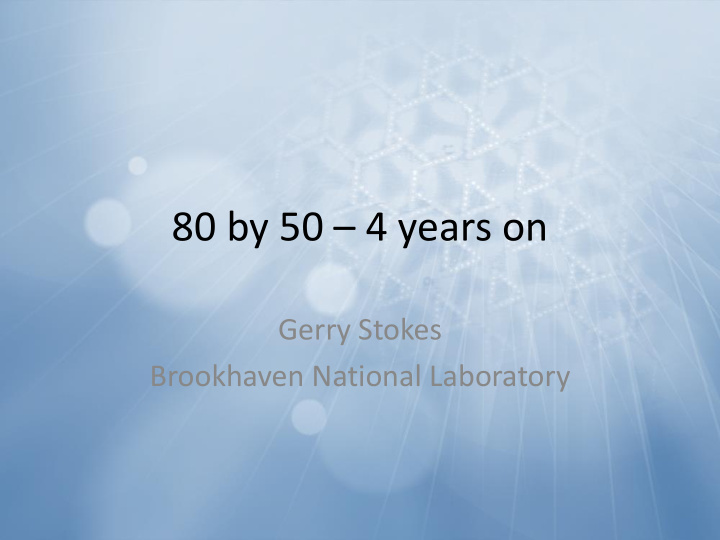



80 by 50 – 4 years on Gerry Stokes Brookhaven National Laboratory
The New York State 80 by 50 Plan • Recognizing the benefits of action and the risks of inaction, in August 2009 the Governor of New York signed Executive Order 24, which tasks the State to reduce GHG emissions from all sources within the state to a level 80% below the 1990 level by 2050. • It established a Climate Action Council that was to develop a Climate Action Plan to achieve that goal, taking into account economic and other considerations, draft released September 30, 2010. BROOKHAVEN NATIONAL LABORATORY
New York doesn’t look like the rest of the country… 6.4% of US population 4.1% of primary energy New York Energy Flows (NYSERDA) “Patterns and Trends: New York State Energy Profiles1994 - 2008”, New York State Energy Research and Development Authority. http://www.nyserda.org/publications/default.asp BROOKHAVEN NATIONAL LABORATORY
What wasthe NYS starting point? Sector CO2 Emissions (MMT CO2) Notes 2007 Baseline BAU (2050) 567x10 6 MBTU Gas Residential 37.6 45.0 154x10 6 MBTU Liquid 431x10 6 MBTU Gas Commercial 27.2 39.1 156x10 6 MBTU Liquid 79x10 6 MBTU Gas Industrial 19.0 24.1 21x10 6 MBTU Liquid 80x10 6 MBTU Coal/Coke 14.8x10 9 VMT HDV Transportation 88.3 126 209.2x10 9 VMT LDV 271,000 GWh Electricity 49.2 83.3 R-88.2; C-140; I-36.3; T-6.2 SF6; NG leaks; Other 28.8 43.0 MSW; HFC Total 250.2 360.5 Note: 1990 emissions = 277 MMT CO2e Making the goal 55.4 MMT CO2e BROOKHAVEN NATIONAL LABORATORY
Three scenarios were developed to illustrate possible 2050 outcomes • Yellow: This scenario could be called a “conventional wisdom” scenario – efficiency and non-biomass renewables are exploited “completely”. It gets us most of the way to the 2050 goal. It highlights the importance of the transport sector in meeting the goal. • Deep Blue: This scenario approached transport using hydrogen as an energy carrier, drives the building sectors to complete electrification, and increases the electrification of the industrial sector. • Ultraviolet: Essentially the same scenario as Deep Blue except that the energy carrier of choice is electricity rather than hydrogen. BROOKHAVEN NATIONAL LABORATORY
Reflecting on the results Sector Ultraviolet Deep Blue Yellow Baseline Notes Residential 37.6/45.0 0 0 7.5 Commercial 0 0 4.5 27.2/39.1 Industrial 12.7 12.7 14.1 19.0/24.1 Transport 20.1 20.1 51 88.3/126 Electricity 10 13 24 49.2/83.3 Other 28.8/43.0 12.3 12.3 12.3 Total 55.1 58.1 113.4 250.2/360.5 Goal – 55.4 • Transport and Industrial (most of other) emissions get the largest share • CCS and nuclear are key to reductions in the electric sector • While presented as zero existing structures will be a major challenge • We have assumed biofuels are carbon neutral BROOKHAVEN NATIONAL LABORATORY
Some technology challenges were clear • The greatest challenge was scale – and the opportunity is reduction in cost of mitigation. • The required solar deployment – grid connected and distributed is substantial. – Grid connected solar alone is 1% of NY State land area • How are the intermittent renewables made more grid friendly? Storage !! • The elimination of diffuse carbon sources pushes energy demand to the grid – can it be ready? • The primary de-carbonized central generation options were nuclear and CCS – what is their future in NYS? BROOKHAVEN NATIONAL LABORATORY
Some further observations at the time • The 80x50 goal is ambitious, and achieving it will require investments in new energy systems and infrastructure that have very low or no net carbon emissions. Patterns of energy use will also need to change. • Energy efficiency is an essential, but not sufficient, strategy that can be aggressively pursued today. • A broad shift from reliance on burning fossil fuels to electricity generated from low- or no-carbon sources, or widespread use of carbon capture and sequestration, will be needed. • Transportation and buildings (residential and commercial) will have to move away from reliance on combustion of fossil fuels to alternate sources with significantly lower carbon or no carbon emissions. • Development and redevelopment based on smart growth principles, as well as the building design practices, building technologies, and construction methods can significantly reduce the energy demand for buildings, as well as transportation. • Incremental, short-term planning cannot achieve the goal. Near-term decisions – both those taken and not taken – can preclude longer-term options, such as infrastructure projects requiring long lead times. Key climate strategies must reflect this reality. BROOKHAVEN NATIONAL LABORATORY
Looking ahead (three and a half years ago)… • There are clearly big decisions necessary to achieve goal – many probably need to made sooner rather than later – infrastructure, fuel sources. – The role of nuclear and CCS – The reliability and capacity of the grid – The role for biomass • The baseline energy scenario is for a very robust economy with a growing industrial base – not the contraction seen since 1990 - and the move to electrification, is consistent with a 21 st Century economy (info, bio and nano). • All renewable energy is from within the state resources, adding a significant sector to the state economy. – How the state cooperates with its neighbors will be important (generation, grid) is important. – Achievement of renewable goals is a critical success factor for the strategy. BROOKHAVEN NATIONAL LABORATORY
Carbon Reservoirs Atmosphere 800 PgC (2004) N. Gas Oil ~260 PgC ~270 PgC Biomass ~500 PgC Soils ~1,500 PgC Coal 5,000 to 8,000 PgC Unconventional Fossil Fuels 15,000 to 40,000 PgC Surface Ocean 1,000 PgC
Now NY State faces a different challenge • The shale gas in the state and other gas elsewhere now suggests a “dash to gas” • With a move to gas there would be an expansion of the gas infrastructure – power, residential and commercial buildings, even vehicles • This infrastructure could cast a shadow into the future strand the asset or not meet the “80 by 50” goal. BROOKHAVEN NATIONAL LABORATORY
Recommend
More recommend